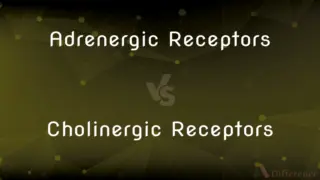Cromlech vs. Dolmen — What's the Difference?
By Maham Liaqat & Fiza Rafique — Updated on March 13, 2024
A cromlech is a prehistoric monument featuring a circle of stones or megaliths, associated with rituals, while a dolmen is a type of single-chamber megalithic tomb, consisting of two or more upright stones supporting a large flat horizontal capstone.

Difference Between Cromlech and Dolmen
Table of Contents
ADVERTISEMENT
Key Differences
Cromlechs, also known as stone circles, are prehistoric structures that consist of a circle of standing stones. These monuments are found across various parts of the world, including Western Europe, and are believed to have been used for ceremonial or ritualistic purposes, such as marking astronomical events. Dolmens, on the other hand, are ancient megalithic tombs that consist of large flat stones laid on upright ones, often found in Europe, Asia, and North Africa. They are believed to have served as burial sites, with the capstone creating a chamber used to house the deceased.
The primary function of cromlechs is thought to be related to social or religious activities, possibly involving astronomy, as some align with solar and lunar events. Dolmens, with their tomb-like structure, had a clear purpose in the burial practices of Neolithic societies, indicating a reverence and possibly beliefs in an afterlife or the importance of ancestors.
Cromlechs are often found in landscapes with other megalithic structures, suggesting they were part of a broader cultural and religious context. Dolmens, while also found within diverse megalithic landscapes, are more specifically associated with funerary practices, often located in places that suggest a strategic choice for burial, such as near settlements or along routes.
The construction of cromlechs involves a significant effort in transporting and erecting large stones in a circular pattern, which implies a strong community effort and possibly a sophisticated understanding of engineering and astronomy. Dolmens, although simpler in concept, require a similar level of engineering skill to balance the heavy capstone atop the upright supports, demonstrating the technological capabilities of their builders.
Both cromlechs and dolmens reflect the complex social, spiritual, and technological worlds of their builders. Cromlechs, with their open, circular layouts, might have served as gathering places for communal activities, while dolmens, with their enclosed spaces, served more private or familial roles in honoring the dead.
ADVERTISEMENT
Comparison Chart
Definition
A circle of standing stones.
A type of megalithic tomb.
Primary Purpose
Ceremonial or ritualistic.
Burial of dead.
Structure
Circular arrangement of stones.
Upright stones supporting a capstone.
Cultural Significance
Associated with astronomical events and rituals.
Indicates burial practices and reverence for ancestors.
Examples
Stonehenge (England), Castlerigg (England)
Poulnabrone Dolmen (Ireland), Gochang Dolmens (South Korea)
Compare with Definitions
Cromlech
Cromlechs are found across various ancient cultures.
The cromlechs in Brittany are aligned with solar events.
Dolmen
Dolmens were used for burials.
Excavations of dolmens often reveal human remains and artifacts.
Cromlech
They may have served as astronomical calendars.
Some cromlechs align with the summer solstice sunrise.
Dolmen
The capstone is supported by upright stones.
The largest dolmens have capstones weighing several tons.
Cromlech
A cromlech is a prehistoric stone circle, often used for rituals.
Stonehenge is one of the most famous examples of a cromlech.
Dolmen
A dolmen is an ancient tomb with a large capstone.
The dolmen at Poulnabrone dates back to the Neolithic period.
Cromlech
Cromlechs required communal effort to build.
Communities likely gathered to erect the massive stones of their local cromlech.
Dolmen
They demonstrate early architectural skill.
The engineering behind dolmens shows sophisticated understanding of weight and balance.
Cromlech
Their purposes remain partially speculative.
Archaeologists debate the full range of uses for ancient cromlechs.
Dolmen
Dolmens are found worldwide.
The Korean Peninsula contains thousands of dolmens.
Cromlech
A cromlech (sometimes also spelled "cromleh" or "cromlêh"; cf Welsh crom, "bent"; llech, "slate") is a megalithic construction made of large stone blocks. The word applies to two different megalithic forms in English, the first being an altar tomb (frequently called a "dolmen"), as William Borlase first denoted in 1769.
Dolmen
A dolmen () is a type of single-chamber megalithic tomb, usually consisting of two or more vertical megaliths supporting a large flat horizontal capstone or "table". Most date from the early Neolithic (4000–3000 BC) and were sometimes covered with earth or smaller stones to form a tumulus.
Cromlech
A portal tomb.
Dolmen
A Neolithic tomb consisting of two or more upright stones with a capstone, believed to have been buried in earth except for a central opening.
Cromlech
A prehistoric monument consisting of a group of megaliths, sometimes arranged in a circle or in concentric circles.
Dolmen
A prehistoric megalithic tomb consisting of a capstone supported by two or more upright stones, most having originally been covered with earth or smaller stones to form a barrow.
Cromlech
A dolmen or ancient underground tomb in Wales, usually made with stones disposed in a circular shape.
Dolmen
More generally, any megalithic tomb, including passage graves and wedge tombs.
Cromlech
A monument of rough stones composed of one or more large ones supported in a horizontal position upon others. They are found chiefly in countries inhabited by the ancient Celts, and are of a period anterior to the introduction of Christianity into these countries.
Dolmen
A cromlech. See Cromlech.
Cromlech
A prehistoric megalith typically having two upright stones and a capstone
Dolmen
A prehistoric megalith typically having two upright stones and a capstone
Common Curiosities
How old are cromlechs and dolmens?
Both types of structures date back to the Neolithic period, roughly 4000 to 3000 BCE.
Do any cromlechs still serve a cultural or religious purpose today?
Some modern pagans and neo-druids regard cromlechs as sacred and use them for ceremonies, although their original purposes may differ.
Are dolmens considered a type of cromlech?
No, dolmens are not considered a type of cromlech; they are distinct structures with different purposes and designs.
Were cromlechs and dolmens built by the same cultures?
While specific builders vary, both structures were constructed by Neolithic societies with megalithic building traditions.
Do all cromlechs have an astronomical purpose?
While not all cromlechs were built with an astronomical purpose, many align with significant solar or lunar events.
How were the massive stones of cromlechs and dolmens transported?
The transportation of these stones likely involved rolling them over logs, dragging them with ropes, and manpower, demonstrating sophisticated organization.
Can cromlechs and dolmens be found in the same regions?
Yes, in many regions, both cromlechs and dolmens are part of the prehistoric landscape, reflecting different aspects of those societies.
How do archaeologists study cromlechs and dolmens?
Archaeologists use a range of methods, including excavation, radiocarbon dating, and landscape archaeology, to study these structures.
How are cromlechs and dolmens preserved?
Many are protected as historical monuments, with efforts made to maintain their condition and protect them from damage.
Are there any legends or myths associated with cromlechs and dolmens?
Many legends and myths have arisen around these structures, often reflecting local folklore and beliefs about their origins and purposes.
Share Your Discovery

Previous Comparison
Glitch vs. Blip
Next Comparison
Thyme vs. RosemaryAuthor Spotlight
Written by
Maham LiaqatCo-written by
Fiza RafiqueFiza Rafique is a skilled content writer at AskDifference.com, where she meticulously refines and enhances written pieces. Drawing from her vast editorial expertise, Fiza ensures clarity, accuracy, and precision in every article. Passionate about language, she continually seeks to elevate the quality of content for readers worldwide.















































